Today in History: November 25
Thanksgiving Day
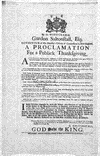
A Proclamation For a Publick Thanksgiving,
By the Honourable Gurdon Saltonstall, Esq; Governour of His Majesty's Colony of Connecticut in New-England 1721.
An American Time Capsule
On the fourth Thursday in November, Americans express gratitude for their good fortune. The American Thanksgiving tradition, celebrated on November 25, 2004, originated with the Pilgrims. As early as 1621, the puritan colonists of Plymouth, Massachusetts set aside a day of thanks for a bountiful harvest. Throughout the colonial period and into the nineteenth century, official days of feasting and fasting commemorated periods of good and poor fortune.
When Boston Harbor was closed in retribution for the Boston Tea Party, for example, Massachusetts authorities declared a fast day. The Virginia House of Burgesses ordered fasting in support of the Bay colony. Complying with the proclamation, on June 1, 1774, George Washington noted in his diary, "Went to Church and fasted all day." Fifteen years later, President George Washington proclaimed the first national Thanksgiving Day under the Constitution.
Whereas it is the duty of all Nations to acknowledge the providence of Almighty God, to obey his will, to be grateful for his benefits, and humbly to implore his protection and favor, and Whereas both Houses of Congress have by their joint Committee requested me "to recommend to the People of the United States a day of public thanks-giving and prayer to be observed by acknowledging with grateful hearts the many signal favors of Almighty God, especially by affording them an opportunity peaceably to establish a form of government for their safety and happiness." Now therefore I do recommend and assign Thursday the 26th. day of November next to be devoted by the People of these States to the service of that great and glorious Being, who is the beneficent Author of all the good that was, that is, or that will be.George Washington, Proclamation, October 3, 1789.
The George Washington Papers at the Library of Congress
Although early Thanksgiving days were spontaneous celebrations, by the mid-nineteenth century an annual fall Thanksgiving meal was customary throughout much of the nation. During the gold rush, miners far from home observed a day of thanks. On December 1, 1850, Alfred T. Jackson of Litchfield County, Connecticut described his California Thanksgiving.
Although there was nothing to show it, we observed Thursday as Thanksgiving, as that was the legal day in the States. All we did was to lay off and eat quail stew and dried apple pie. I thought a lot about the old folks and would like to have been home with them, and I guess I will be next year…Alfred T. Jackson, December 1, 1850
The Diary of a Forty-Niner p. 38.
California As I Saw It: First Person Narratives, 1849-1900
Writer/editor Sarah Josepha Hale pushed for an annual day of national Thanksgiving. From the helm of several prominent women's magazines, Hale editorialized about the importance of an national Thanksgiving celebration. On October 3, 1863, in the wake of victory at Gettysburg, President Abraham Lincoln decided to issue a Thanksgiving Proclamation that declared the last Thursday in November national Thanksgiving Day. The President's Hymn, composed in honor of the new holiday, rang out across the nation.
Give thanks, all ye people, give thanks to the Lord,
Alleluias of freedom with joyful accord:
Let the East and the West, North and South roll along,
Sea, mountain and prairie, One thanksgiving song.The President's Hymn, 1863.
"We'll Sing to Abe Our Song!": Sheet Music about Lincoln, Emancipation, and the Civil War
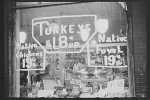
Butcher Shop Window At Thanksgiving, Norwich, Connecticut,
Jack Delano photographer, November 1940.
FSA/OWI Photographs, 1938-1944
It was in 1941 that Congress fixed the Thanksgiving holiday as the fourth Thursday in November.
Learn more about America's Thanksgiving traditions:
- African American Perspectives 1818-1907 contains five Thanksgiving day addresses from the period 1875-1897. Search the collection on the term thanksgiving to read sermons which include Benjamin William Arnett's Centennial Thanksgiving Sermon.
- Recall past Thanksgiving Days. Search the collection American Life Histories on Thanksgiving, Thanksgiving dinner, and turkey to access interviews like A Preacher Tries Farming.
- Read The Frontier Holiday. This collection of brief first-person descriptions chronicles the celebration of Christmas, New Year's, and Thanksgiving in nineteenth-century Minnesota. Find this book and other pioneer recollections by searching Pioneering the Upper Midwest on Thanksgiving.
- Search on the terms turkey, harvest, pumpkin, or canning in the collection Tending the Commons to see images, and hear tell of events, associated with the U.S. Thanksgiving celebration. (Thanksgiving is celebrated on the second Monday in October in Canada.)
Santa Catalina Island
"Twenty-six miles across the sea,
Santa Catalina is awaitin' for me…"sung by the Four Preps
words and music by G. Larson & B. Belland
Beechwood Music Corp., 1958
On November 25, 1602 explorer Sebastián Vizcaíno gave its present name. The native Pimungan people called their island Pimu. In 1542, Juan Rodríguez Cabrillo, the first European explorer to encounter the island, referred to it as San Salvador. When Vizcaíno sheltered on the island in 1602 he renamed it Catalina, in honor of the feast day of Saint Catherine of Alexandria.

Avalon, Catalina Island, 1911
Taking the Long View, 1851-1991
Archaeological evidence shows the island was inhabited by maritime hunter-gatherers for at least six thousand years. Members of the Uto-Aztecan language family, these people developed a strong seagoing trade with residents of both nearby islands and the mainland.
Aleut, Russian, and American hunters trapped otters in Santa Catalina waters while the island was controlled by Spain. Under subsequent Mexican rule, smugglers used Santa Catalina as a warehouse for undeclared cargo. Under the Treaty of Guadalupe Hidalgo Santa Catalina became part of the United States.
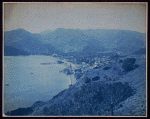
Avalon from the north, Santa Catalina Island, circa 1907-15.
Touring Turn of the Century America, 1880-1920
In his 1898 book Happy Days in Southern California, Frederick Hastings Rindge wrote lyrically of the island:
In the distance the islands—Santa Catalina (Saint Catherine's Isle), Santa Barbara, and Santa Cruz—hold up their haughty heads, proud of their victories over the storms.
On San Miguel Island, off Santa Barbara City, Juan Rodriguez Cabrillo, the first explorer of the California coast, was buried. In aboriginal days, these islands were more populous than the mainland.
But Catalina is the isle that appeals to the people. Her rock-bound coasts are jeweled with abalones: she is the queen of the sea's domain. Wonderful is she for her submarine gardens in the still waters.
The abalone shells are sent to New York to be made into buttons, and are brought back to California for sale. They should be made here and give wages to our own.Frederick Hastings Rindge
"By the Side of the Sunset Sea," Happy Days in Southern California, 1898.
California as I Saw It, 1849-1900
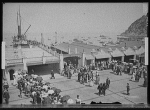
Steamship ticket office at pier, Avalon, Catalina Island, California, circa 1900-1915.
Touring Turn of the Century America, 1880-1920
In the 20th century tourists traveled to Santa Catalina to visit its hotels and watch its famous flying fish. Avalon, the island's only city, was incorporated in 1919. That year commercial flights to the Santa Catalina airport accounted for half of the nation's air traffic. Today, nearly nine-tenths of the island is owned by a non-profit conservancy. Although a popular song of the 1950s said Santa Catalina is "26 miles across the sea," it is just 22 miles from Los Angeles.
- View more images of the island. Search the American Memory pictorial collections on the term Santa Catalina. Touring Turn-of-the-Century America, 1880-1920 and Taking the Long View, 1851-1991 contain photographs of the island's early resort days.
- A 1720 map of California by Nicolas de Fer is available through the Discovery and Exploration section of Map Collections (1500-Present). Zoom in on the cluster of islands to see the Isla d. Sa. Catalina — Santa Catalina Island.
- California as I Saw It: First-Person Narratives of California's Early Years, 1849-1900 offers two versions of a California regional map that includes Santa Catalina. Examine the small file (80k jpg) version, or view the large file (500k jpg) version.
Business is Booming
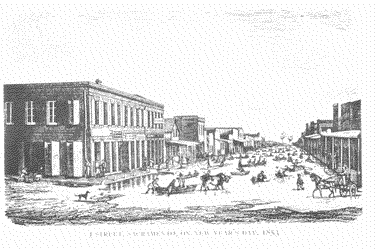
J Street, Sacramento on New Year's Day, 1853.
Published in Frankin A. Buck, A Yankee Trader in the Gold Rush, page 58.
California As I Saw It, 1849-1900
"I have not come 20,000 miles," Yankee trader Franklin A. Buck wrote to his sister Mary on November 25, 1849, "to turn around and go right back again like some persons who have been here and gotten homesick." Just twenty years old, Buck left his job in New York and set sail for California the previous January. The young man was one of 40,000 people who traveled to California by sea during the gold rush of 1849. He arrived in the boom town of Sacramento City in October. With partners, Buck opened a supply store. Business was brisk.
"Week before last," Buck boasted to his sister, "we sold out of our little store $1500 worth of goods. All cash trade in one day. Tell Joseph to beat that…The flour that I bought in San Francisco for $18 per sack (200 lbs) we sold for $44 and are all out." As 1849 drew to a close, Buck noted Sacramento consisted of "over 800 framed buildings, besides the tents."
Broadcasting his good fortune, Franklin Buck extolled California's temperate climate. "Today is Sunday," he wrote. "Gloomy November, probably, with you, but here the weather is splendid, not cold enough to need a fire. Although this is the winter or rainy season it has rained about 15 days out of this month so far." Despite enthusiasm for his new life, Buck could not conceal homesickness and nostalgia for the past crept into his letter:
I should like to be at home on Thanksgiving Day. I suppose you have had or will have one about this time. (Bake me a turnover!) Be sure and write me all about it. I look forward with great pleasure to spending a Thanksgiving with all the family once more in my life…We were blest, Mary, with the best of parents and a happy home. Probably they were the happiest years of our lives—those that we spent at home.Franklin A. Buck to Mary Sewall Bradley, November 25, 1849.
A Yankee Trader in the Gold Rush,
California As I Saw It, 1849-1900
Learn more about pioneer life:
- California as I Saw It: First-Person Narratives, 1849-1900 documents the formative era of California's history through eyewitness accounts. Explore the collection by browsing the author, subject, or title index. Or, search the collection on a keyword of your choice. Early California History: An Overview provides an introduction to the era.
- Read additional recollections of life on the frontier by searching American Life Histories, 1936-1940 and Pioneering the Upper Midwest: Books from Michigan, Minnesota, and Wisconsin, ca. 1820-1910 on pioneer or settler.
- Learn about ranching life yesterday and today. Buckaroos in Paradise documents a Nevada cattle-ranching community, with a focus on the family-run Ninety-Six Ranch.
- Search the Today in History Archive on the names of states like Utah, Kansas, or the Dakotas to learn more about settling the West.